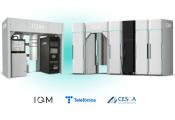ESA Project Achieves Space-Enabled Quantum Key Distribution Link Milestone
November 21, 2024 -- ESA, together with a Starion-led industrial consortium, has marked a significant milestone in quantum communications technology with the successful implementation of a terrestrial quantum key distribution (QKD) link. The link took place between its European Space Security and Education Centre (ESEC) in Belgium and a data centre in Luxembourg. The development comes as part of the International Use Cases for Operational QKD Applications and Services (INT-UQKD) project, which exemplifies ESA's commitment to bridging the gap between advanced space technology and practical business applications.
Through its Space Systems for Safety and Security (4S) programme, as part of the wider Advanced Research in Telecommunications Systems (ARTES) programme, ESA has brought together a consortium of European and international partners, including Starion Luxembourg, POST Luxembourg, the University of Luxembourg's SnT, HITEC Luxembourg, evolutionQ (Canada), and SpeQtral (Singapore).
ESA’s ESEC establishment hosts two critical cybersecurity operations: the Security Cyber Centre of Excellence (SCCoE) and the Cyber Safety and Security Operations Centre (CSOC), underlining ESA's comprehensive approach to digital security. The project's significance extends beyond technological achievement: by focusing on operational IT environments in regulated sectors, particularly financial institutions, INT-UQKD is addressing critical market needs.
The terrestrial link's successful activation serves as a foundation for the project's next phase: establishing a space-based QKD link between Luxembourg and Singapore. This expansion will utilise the Speqtre and Speqtral-1 satellites and a new optical ground station in Luxembourg, all currently under development. The combined terrestrial and satellite infrastructure will demonstrate the feasibility of quantum-secure communications across global networks.
ESA's initiative comes at a crucial time, as quantum computing developments threaten to compromise existing cryptographic methods within the next five to ten years. The INT-UQKD project addresses this challenge by combining QKD technology with post-quantum cryptography, creating a comprehensive security solution for interconnected networks.
ESA and the consortium are also working to align with national quantum communications programmes to advance European leadership, while ensuring that the resulting technologies serve practical commercial needs. The successful implementation of the terrestrial QKD link represents a significant step towards establishing a quantum-safe communications infrastructure that will protect European businesses and citizens in the quantum computing era.
Marc Welter, the project’s Technical Officer within ESA’s Connectivity and Secure Communications directorate, added: “We are delighted by the progress of the INT-UQKD project to date. This first quantum-secured terrestrial link is especially notable because it is based at ESEC, which is at the heart of a growing cybersecurity hub in southern Belgium. Cybersecurity is a key focus for ESA and our two new cybersecurity centres operate from here: the SCCoE and the CSOC. Having first-class cybersecurity is not only essential for space; it is also vital for all critical infrastructures and regulated sectors, and putting the focus on use cases is why this project is unique.”
Nicolas Ramponi, Operations Director Belux, Starion Luxembourg, said: “This milestone review meeting was very positive as it marked the operational success of the INT-UQKD project’s first terrestrial link. What’s important to recognise, however, is that the project’s overall success will be judged by its application in real-world use cases, such as finance and other regulated sectors. This isn’t a project that solely focuses on the technology – instead, we want to make it as straightforward as possible for banks and other businesses to transition to quantum-safe communications and know they have trusted, secure communications in the face of the significant cyber threats emerging from quantum computing.”
The 4S strategic programme line develops innovative secure satellite communication systems, integrating them with terrestrial networks where relevant. Through projects, such as INT-UQKD, the programme aims to enhance the safety, resilience, and security of our critical infrastructures and applications, including transportation across land, air, and sea.
The 4S initiative aims to support European and national institutions and public bodies in building satellite communications tailored to their needs, while also maintaining Europe’s position at the forefront of the global secure communications market. By fostering growth in this domain, the initiative contributes to creating a safer and more resilient society in Europe and beyond.




































